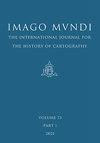Amerigo Vespucci: The Historical Context of His Explorations and Scientific Contribution
IF 0.5
4区 历史学
Q4 GEOGRAPHY
Imago Mundi-The International Journal for the History of Cartography
Pub Date : 2021-07-03
DOI:10.1080/03085694.2021.1960046
引用次数: 0
Abstract
other images, such as the mythical El Dorado and the Laguna de los Xaraies (Xarayes Lake), the immense and rich lake believed to lie in the centre of the continent, while also motivating contemporary expectations. After Spain’s violent encounter with the Inca Empire, and its incommensurable wealth, the experiences reported in Spanish accounts also appeared in the Portuguese narratives, produced mainly by the Peruleiros, who managed the silver traffic along with the Spaniards. In this way, Doré’s book traces a different history of cartography from that found in the seminal works of the Mexican philosopher Edmundo O’Gorman (1906–1995). In her eyes America is equally an invention, a cross section and a synthesis of what it is supposed to be. In analysing these processes, Doré makes us think about the act of naming. She reminds us of the twentiethcentury French Jesuit Michel de Certeau’s perspective, according to which European possession of South America was effected by an act of intellectual appropriation. Doré, however, seeks to authenticate the historical implications of this act by focusing on one idea that did not prevail, the promise of America Peruana. Historicity, she shows us, is still open to reinvention.韦斯普奇探索与科学贡献的历史语境
其他图像,如神话中的El Dorado和Laguna de los Xaraies(Xarayes湖),这座巨大而富饶的湖泊被认为位于非洲大陆的中心,同时也激发了当代人的期望。在西班牙与印加帝国的暴力冲突及其无法估量的财富之后,西班牙记述中的经历也出现在葡萄牙的叙述中,主要由佩鲁莱罗斯人产生,他与西班牙人一起管理白银运输。通过这种方式,多雷的书追溯了一段不同于墨西哥哲学家埃德蒙多·奥戈尔曼(Edmundo O'Gorman,1906-1995)开创性著作的地图学历史。在她眼中,美国同样是一项发明,一个横截面,是对它应该是什么的综合。在分析这些过程时,Doré让我们思考命名的行为。她让我们想起了20世纪法国耶稣会士米歇尔·德·塞尔托的观点,根据这一观点,欧洲对南美洲的占有是由知识侵占行为影响的。然而,多雷试图通过关注一个没有盛行的想法来验证这一法案的历史意义,即美国的承诺。她向我们展示了历史性,它仍然可以被重新创造。
本文章由计算机程序翻译,如有差异,请以英文原文为准。
求助全文
约1分钟内获得全文
求助全文
来源期刊
CiteScore
0.20
自引率
0.00%
发文量
32
期刊介绍:
The English-language, fully-refereed, journal Imago Mundi was founded in 1935 and is the only international, interdisciplinary and scholarly journal solely devoted to the study of early maps in all their aspects. Full-length articles, with abstracts in English, French, German and Spanish, deal with the history and interpretation of non-current maps and mapmaking in any part of the world. Shorter articles communicate significant new findings or new opinions. All articles are fully illustrated. Each volume also contains three reference sections that together provide an up-to-date summary of current developments and make Imago Mundi a vital journal of record as well as information and debate: Book Reviews; an extensive and authoritative Bibliography.

 求助内容:
求助内容: 应助结果提醒方式:
应助结果提醒方式:


